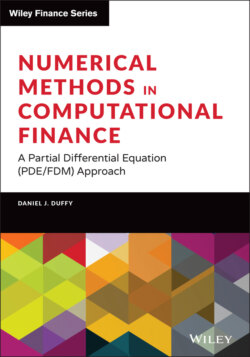Читать книгу Numerical Methods in Computational Finance - Daniel J. Duffy - Страница 59
3.4.1 Stochastic Differential Equations (SDEs)
ОглавлениеWe give a short introduction to stochastic differential equations (SDEs) as they are closely related to ODEs. We discuss SDEs in more detail in Chapter 13.
We introduce the scalar random processes described by SDEs of the form:
where:
random process
transition (drift) coefficient
diffusion coefficient
Brownian process
given initial condition
defined in the interval [0, T]. We assume for the moment that the process takes values on the real line. We know that this SDE can be written in the equivalent integral form:
This is a non-linear equation, because the unknown random process appears on both sides of the equation and it cannot be expressed in a closed form. We know that the second integral:
is a continuous process (with probability 1) provided is a bounded process. In particular, we restrict the scope to those functions for which:
Using this fact, we shall see that the solution of Equation (3.17) is bounded and continuous with probability 1.
We now discuss existence and uniqueness theorems. First, we define some conditions on the coefficients in Equation (3.17):
C1: such that .
C2: , such that
C3: and are defined and measurable with respect to their variables where .
C4: and are continuous with respect to their variables for .
Condition C2 is called a Lipschitz condition in the second variable, while condition C1 constrains the growth of the coefficients in Equation (3.17). We assume throughout that the random variable is independent of W(t).
Theorem 3.2 Assume conditions C1, C2 and C3 hold. Then Equation (3.17) has a unique continuous solution with probability 1 for any initial condition .
Theorem 3.3 Assume that conditions C1 and C4 hold. Then the Equation (3.17) has a continuous solution with probability 1 for any initial condition .
We note the difference between the two theorems: the condition C2 is what makes the solution unique. Finally, both theorems assume that is independent of the Brownian motion W(t).
We now define another condition on the diffusion coefficient in Equation (3.17).
C5: and for every there exists an and such that:
Theorem 3.4 Assume conditions C4, C1 and C5 hold. Then the Equation (3.17) has a continuous solution with probability 1 for any initial condition .
For proofs of these theorems, see Skorokhod (1982), for example.
In some cases it is possible to find a closed-form solution of Equation (3.17) (or equivalently, Equation (3.18)). When the drift and diffusion coefficients are constant, we see that the exact solution is given by the formula:
(3.19)
Knowing the exact solution is useful, because we can test the accuracy of finite difference schemes against it, and this gives us some insights into how well these schemes work for a range of parameter values.
It is useful to know how the solution of Equation (3.17) behaves for large values of time; the answer depends on a relationship between the drift and diffusion parameters:
In general it is not possible to find an exact solution, and in these cases we must resort to numerical approximation techniques.
Equation (3.17) is a one-factor equation because there is only one dependent variable (namely ) to be modelled. It is possible to define equations with several dependent variables. The prototypical non-linear stochastic differential equation is given by the system:
where:
In general the drift and diffusion terms in (3.20) are non-linear:
This is a generalisation of Equation (3.17). Thus, instead of scalars this system employs vectors for the solution, drift and random number terms while the diffusion term is a rectangular matrix.
Existence and uniqueness theorems for the solution of the SDE system (3.20) are similar to those in the one-factor case. For example, theorem 5.2.1 in Øksendal (1998) addresses these issues. We discuss SDEs in more detail in Chapter 13.
